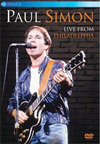Paul Simon – Live From Philadelphia
Get the bus, Gus, make a new plan, Stan, you don't need to be coy Roy, just listen to me…
At one point or another in our lives, we've more than likely recited this classic scat from Paul Simon's funk rock classic "50 Ways to Leave Your Lover." Certainly a wild one-eighty from the days of "Mrs. Robinson" and "Bridge Over Troubled Waters" when Simon and Garfunkel lit the world on fire with their sometimes tragic-sounding folk rock of the sixties. Back then, Paul Simon and his shotgun partner Art was writing amidst a climate of social upheaval and their music revealed and intense introspective window into their generation.
By the time Simon and Garfunkel decided enough was enough, a new decade had turned as Art Garfunkel went in the direction of acting. Paul Simon of course continued to write music and always from the heart, but during the seventies (the last truly great era of pop) a little more libido and sexuality crept into his music. Nothing blatant but there was more of a deeply-buried angst in Simon's keyboard-drenched seventies adult rock that manifested on his 1975 best seller "Still Crazy After All These Years" (of which marked a songwriting reunion with Art Garfunkel). "50 Ways to Leave Your Lover" became the anthem for would-be divorcees or at least those involved in sour relationships; the song was a take-no-shit pride inducer that can still bring a crowd to its feet when Simon plays it live.
By the time this concert in 1980 filmed at Philadelphia's Tower Theatre arrived in Paul Simon's career, he had already experimented with jazz, fusion, soul and reggae. A lot of his music to this point was of a sedate candor though always filled with sensitive and though-provoking lyrical content. Certainly shades of the poets who wrote "The Boxer" could be found in "Jonah," "American Tune" and "Still Crazy After All These Years," each of which make an appearance in this decidedly laidback performance.
Simon and his ensemble (featuring jazz guitarist Eric Gale, drummer Steve Gadd, pianist Richard Tee, keyboardist Paul Levin and his brother, famed bassist Tony Levin) poke and plod along on "Paul Simon Live From Philadelphia" but there's a staunch professionalism to the whole thing where saxophone and flute chime in on cue when needed and the rest of the crew backs Simon up with down-tempo stage personae, allowing him to wax his lyrical sonnets to an appreciative mutton-chopped and polyester-clad audience.
The whole affair is a New York, er, Philadelphia Minute as Paul Levin swamps the set with moody Moog, as was fashionable in pop rock of the seventies. Ask Billy Joel how effective wavy keys were to his comeuppance years. They're only out of place when Paul Simon appeases his spectators with "The Boxer," which is still wonderfully morose from a vocal standpoint, yet sadly the climactic orchestra accompanying the Simon and Garfunkel version leaves any renditions thereafter anti-climactic.
On the other hand, Simon nails a beautiful one-man-show with "The Sound of Silence" and he creates an instant party with his samba-laced "Late in the Evening," the latter of which is almost like a jolt compared to the ragtag pace of the set numbers preceding.
Simon after this point would go on to record his most poignant and acclaimed albums of his career, "Graceland" and "Rhythm of the Saints." In some ways, "Paul Simon Live From Philadelphia" is a diminutive pause between the greatness of Simon and Garfunkel and the stellar craftsmanship of his mid-eighties work. This is a perfectly agreeable set to get cozy with, but let's face it; if you want to get the crowd appropriately worked-up, you drag Art onstage and make them peel off "Cecilia."







